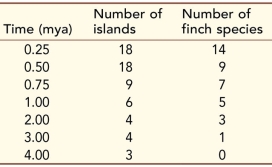The different finch species in the phylogeny shown in the 22.8 of the textbook have all evolved on islands of the Galápagos archipelago within the past 3 million years.Molecular clock analysis (see Chapter 23) has been used to determine the dates of the various speciation events in the phylogeny.Geological techniques for dating rock samples (see Chapter 24) have been used to determine the ages of the various Galápagos islands.The table shows the number of species of Darwin's finches and the number of islands that have existed in the archipelago at several times during the past 4 million years.  Plot the number of species of Darwin's finches and the number of islands in the Galápagos archipelago (dependent variables) against time (independent variable).
Plot the number of species of Darwin's finches and the number of islands in the Galápagos archipelago (dependent variables) against time (independent variable).
Are the data consistent with the hypothesis that isolation of populations on newly formed islands is related to speciation in this group of birds? Why or why not?
Definitions:
Selective Attention
Selective attention is the process by which a person focuses on one particular object or task while ignoring other stimuli or information.
Cocktail Party Effects
The ability to focus one's auditory attention on a particular stimulus while filtering out a range of other stimuli, as if at a noisy party.
Inattentional Blindnesses
A psychological phenomenon where an individual fails to perceive an unexpected stimulus in plain sight when their attention is focused on another task or aspect of their environment.
Evolutionary Psychology
A contemporary evolutionary perspective used in the social and natural sciences to scrutinize psychological structures.
Q9: The table shows the ancestral and derived
Q23: In a population of hamsters, some individuals
Q38: Which source of molecular data would be
Q48: The primary function of ribosomal RNA gene
Q58: Scientists use sequence alignment to identify _
Q108: The dominant mode of speciation in most
Q127: According to the Dobzhansky-Muller model, the evolution
Q142: Refer to the table. <img src="https://d2lvgg3v3hfg70.cloudfront.net/TB5650/.jpg" alt="Refer
Q181: The wheat that we commonly eat is
Q238: Refer to the figure. <img src="https://d2lvgg3v3hfg70.cloudfront.net/TB5650/.jpg" alt="Refer